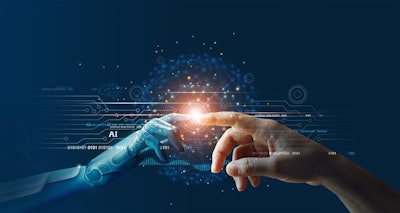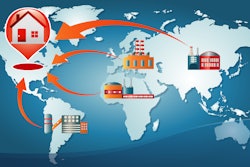
Would you work for a robot? The question might seem crazy, but according to a study conducted by a UK-based recruitment firm, up to a quarter of employees would consider swapping their line manager for an artificially intelligent alternative.
You can see the advantages - a virtual line manager is far less likely to have a bad day at the office - but the downsides are pretty obvious too. For all the technical wizardry that allows automated and AI-driven machines to complete certain tasks faster and more accurately than their human counterparts, when it comes to building and nurturing relationships, they suck.
There are important lessons here for businesses as they consider the future of their supplier relationships, not least the dangers of seeing technology alone as the end-all be-all to problems surfaced over the past two years. With the supply chain standing on the cusp of its own digital moment it’s time to examine where tech can transform businesses for the better - and why the input and value of human relationships is so critical to any successful transition.
Digital delayed
Building better human relationships across the supply chain starts with the foundations that underpin the way buyers and suppliers connect and communicate. Digital technology has brought a “relationship revolution” to our daily lives, enabling family members to communicate across continents, matching employers to job seekers, even helping people find love. Yet it’s a revolution that has almost entirely passed by many business departments.
Even now I hear businesses claiming that switching from paper to PDF falls under their digital transformation strategy. Rather than reimagining the processes which underpin their relationships across the supply chain, many businesses have simply replicated a set of old problems in an electronic format.
Portal problems
Supplier portals are a great example of the kind of pseudo-digitization that fails to grasp the true potential of technology to build a new kind of connection between buyers and suppliers. Relationships between businesses have evolved from one-to-one, linear engagements, into complex ecosystems of interconnectivity between buyers and suppliers spanning the globe. Business software designed to facilitate this connective tissue has failed to deliver the goods.
Rather than making it easy for businesses to connect with each other, each 1:1 connection between buyer and supplier requires a complex and time-consuming integration. It’s no wonder that even the most successful supplier onboarding initiatives only see around 20% adoption rates.
Click here to hear more about technology and human workers:
The network effect
Imagine the only way you could search or apply for a job was to sign up with individual companies to receive notifications and gain access to their jobs portal. Many of us can actually remember when things were just like that - but it sounds ridiculous to a generation used to LinkedIn and Indeed.com because the benefits of these networks are self-evident.
The social networks we use in our personal lives help us form connections and share information pretty much effortlessly. Instead of the hub-and-spoke, one-to-one relationship model, buyers should be focused on creating a fully-digitized environment that connects buyers with suppliers and, crucially, with each other - just like LinkedIn or any other online community.
From the buyer’s perspective, the network model is attractive because it allows them to get a much more holistic view across their supply chain. It allows decision makers to spot single points of failure and make informed choices quickly about how to manage them. And the enhanced ability to collaborate with sellers and other parties in their supply chain ecosystem means decisions, including finding new suppliers, can be implemented more quickly, which is critical in times of stress.
Furthermore, the robust data that these systems provide into buyer and supplier relationships opens the door to a range of innovations that offer value to suppliers—from increased access to curated marketplaces where they can seek out fresh commercial opportunities, to digitized financing options that help them unlock faster access to working capital.
Automation works…
The benefits of a network approach are obvious to every party, but they will only be successful if they represent a step-change in day-to-day operations by simplifying processes and removing friction.
This is one area where “the robots” are ideally suited. Mundane and time-consuming tasks like matching invoices to purchase orders are necessary but low-value tasks, taking a huge proportion of employees’ time. Invoice processing is a good example. According to Ardent Partners, payables teams spend an average of 24% of their time handling invoice exceptions.
Automation eats these types of tasks for breakfast, doing it faster and more accurately than even the most dedicated human employee. It’s obvious where workers can reinvest their time: in renewing and strengthening relationships - something you’d never ask a robot to do.
…but it can’t replace the human factor
One of the most pervasive and stubborn misconceptions about digital is that it’s about incremental gains: “If we digitize x% of processes, we’ll see x% return.” This type of narrow thinking has led many a business down a digital dead-end and is one of the reasons why 70% of corporate transformation initiatives fail.
Ultimately, it’s not really about tech at all: it’s about whether businesses have the vision to understand their partners’ pain points, and the ambition to collaborate on projects that bring mutual benefit. Digitalization and automation provide the foundation and the tools to deliver this insight while enabling employees to focus on what only humans can do.
The pandemic and the ensuing chaos in international supply chains has refocused minds and made businesses realize that buyer-supplier relationships are more complex - and more precious - to be reduced to a line item on a balance sheet. Having struggled through the long, dark days of lockdown, many employees have carried the added anxiety of wondering whether they’ll soon be made redundant by machines. Businesses should give their workers peace of mind and let them know what we tell our own partners: automation is perfect for processes, but creating and nurturing real relationships demands the human touch.



















